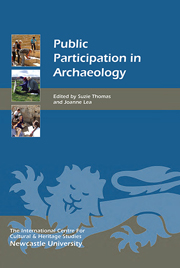Book contents
- Frontmatter
- Dedication
- Contents
- List of Illustrations
- Acknowledgments
- List of Abbreviations
- Preface
- Introduction
- Public Participation in Archaeology: International Models
- Public Participation in Archaeology Through Education
- 6 Accessing Archaeology in the School System: Powerful Partnerships — a Case Study of the Challenges and Rewards for Archaeologists, Teachers and Students (Canada)
- 7 Hook 'em When They're Young: Using Enquiry-Based Learning Workshops in Archaeology
- 8 Archaeology as Culturally Relevant Science Education: The Poplar Forest Slave Cabin
- 9 Heritage Education in Jordanian Schools: For Knowledge or Profit?
- Public Participation in Archaeology Through Tourism
- Public Participation in Archaeology Through Site Management and conservation
- List of Contributors
- Index
8 - Archaeology as Culturally Relevant Science Education: The Poplar Forest Slave Cabin
from Public Participation in Archaeology Through Education
Published online by Cambridge University Press: 05 August 2014
- Frontmatter
- Dedication
- Contents
- List of Illustrations
- Acknowledgments
- List of Abbreviations
- Preface
- Introduction
- Public Participation in Archaeology: International Models
- Public Participation in Archaeology Through Education
- 6 Accessing Archaeology in the School System: Powerful Partnerships — a Case Study of the Challenges and Rewards for Archaeologists, Teachers and Students (Canada)
- 7 Hook 'em When They're Young: Using Enquiry-Based Learning Workshops in Archaeology
- 8 Archaeology as Culturally Relevant Science Education: The Poplar Forest Slave Cabin
- 9 Heritage Education in Jordanian Schools: For Knowledge or Profit?
- Public Participation in Archaeology Through Tourism
- Public Participation in Archaeology Through Site Management and conservation
- List of Contributors
- Index
Summary
Introduction
While archaeology is not typically taught as a school subject (Kindergarten through to 12th Grade; ages 5—18 years), it is proving to be effective for teaching and learning in upper elementary grades in the United States of America (USA) and Canada (Smardz and Smith 2000). Because archaeology is interdisciplinary, teachers can use it to integrate usually unrelated subjects such as science, social studies, history, language arts and mathematics within traditional schooling contexts (and see MacDonald, Chapter 6). Historic preservation is an important part of archaeological practice and the issues of preservation, such as mitigating the threats that development poses to archaeological sites and personal responsibility for protection of archaeological resources on public lands, lend themselves well to teaching, learning and practising citizenship skills.
Over the past 30 years, many archaeology education efforts in the USA have been designed to prevent looting and vandalism of archaeological sites (Smardz Frost 2004; Little 2012). The 1988 amendments to the Archaeological Resources Protection Act (ARPA) in the USA explicitly instruct federal land managing agencies to ‘…establish a program to increase public awareness of the significance of the archaeological resources located on public lands and Indian lands and the need to protect such resources’ (United States Code 16 USC 470ii[c] n.d.). Innovative archaeological education curriculum materials have been developed to help fulfil these requirements (Smith et al 1992; 1993).
- Type
- Chapter
- Information
- Public Participation in Archaeology , pp. 89 - 104Publisher: Boydell & BrewerPrint publication year: 2014



